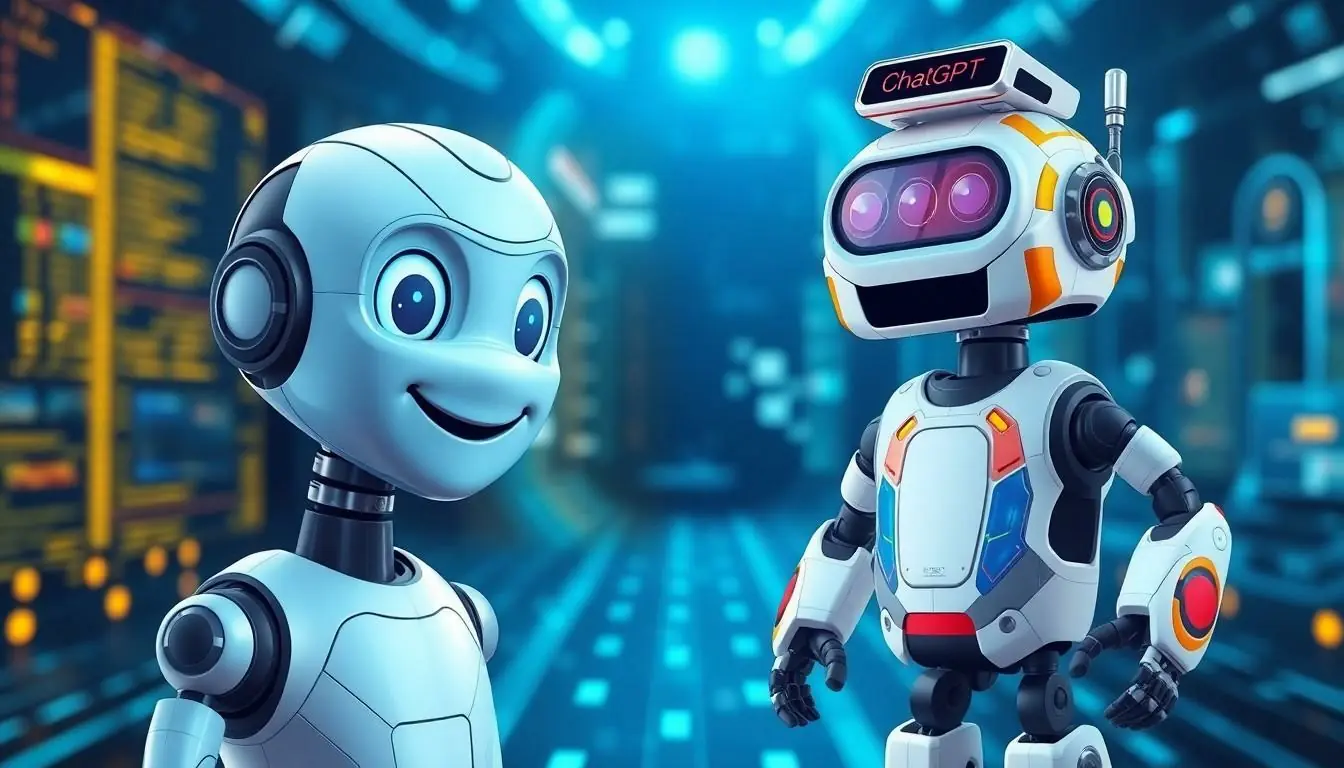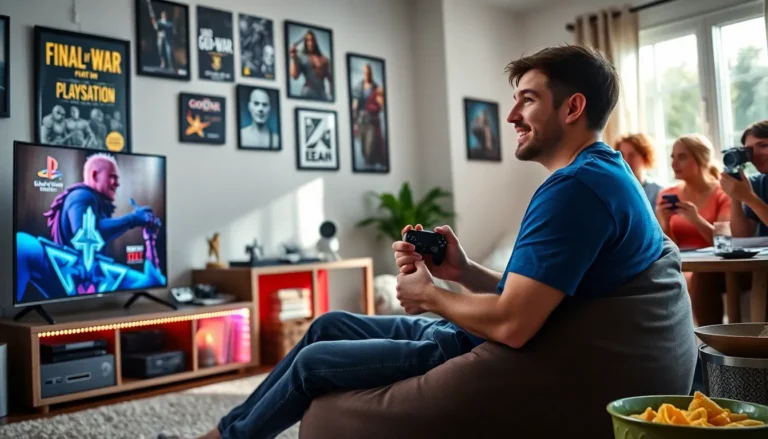Table of Contents
ToggleIn the ever-evolving world of AI chatbots, two heavyweights are vying for the crown: Claude and ChatGPT. Picture a friendly showdown where these digital brainiacs flex their linguistic muscles, each claiming to be the ultimate conversational partner. But which one truly deserves the title of “best chatbot”?
Overview of Claude and ChatGPT
Claude and ChatGPT are two prominent AI chatbots, each offering unique strengths in conversational interactions. This section explores their key features.
Key Features of Claude
Claude excels in natural language understanding and contextual awareness. It processes queries with remarkable accuracy and delivers responses that align closely with user intent. This chatbot offers robust customization options, allowing users to adjust its tone and style. Claude’s streamlined interface enhances user experience. It also supports multi-turn conversations, maintaining context over extended dialogues. Additionally, its integration capabilities with third-party applications provide flexibility in various use cases.
Key Features of ChatGPT
ChatGPT stands out for its conversational fluency and versatility. It handles a broad range of topics, enabling engaging discussions across diverse subjects. The model utilizes advanced algorithms to generate coherent and contextually appropriate responses. Users appreciate its ease of access, available through multiple platforms and interfaces. ChatGPT also includes a learning component, evolving with user interactions to improve responses over time. Its frequent updates ensure the model stays relevant and reliable in dynamic conversational settings.
Performance Comparison

Both Claude and ChatGPT demonstrate distinct capabilities in the realm of AI chatbots, each showcasing strengths tailored to various user needs.
Language Understanding
Claude excels in natural language understanding. It effectively comprehends context, allowing for nuanced interactions. Its ability to grasp user intent enhances conversational flow, making it ideal for tasks requiring precise engagement. ChatGPT, while also proficient, showcases versatility across a broader range of topics. It presents a more general understanding, consistently generating responses that resonate with varied queries. Users often appreciate Claude for its contextual awareness, ensuring responses remain relevant. ChatGPT stands out for its adaptability, learning from user interactions to refine its language handling. Each chatbot serves specific preferences, with Claude focusing on depth while ChatGPT emphasizes breadth.
Response Quality
Response quality varies between Claude and ChatGPT, with both aiming for clarity and relevance. Claude provides concise, context-rich answers that foster deeper discussions. Users frequently find its responses informative and detailed, particularly in specialized subject areas. ChatGPT generates fluent and coherent responses, making it effective for casual conversations. Feedback from users suggests they enjoy its engaging style, especially when navigating a wide array of topics. Excellent formatting in outputs further enhances clarity for both chatbots. Despite differences, both prioritize user satisfaction through high-quality responses, catering to distinct conversational objectives.
Use Cases and Applications
Both Claude and ChatGPT serve diverse needs across various applications, showcasing their strengths in different contexts.
Best Use Cases for Claude
Claude excels in environments requiring nuanced conversations. Its deep understanding of context enables it to engage in specialized discussions, such as legal or medical topics. Users benefit from robust customization features, allowing tailored interactions. Businesses rely on Claude for customer support, where accurate and context-rich responses foster meaningful engagement. Educational applications thrive with Claude, as it helps students delve into complex subjects, offering detailed explanations. Furthermore, research teams utilize Claude for analyzing intricate datasets, providing insights based on advanced comprehension.
Best Use Cases for ChatGPT
ChatGPT shines in versatile scenarios. It functions well in casual conversations, making it ideal for social media interactions and friendly exchanges. Content creators utilize ChatGPT to brainstorm ideas, benefiting from its ability to generate creative content quickly. Additionally, it assists in language learning, offering practice through engaging dialogues. Companies employ ChatGPT in FAQs, facilitating quick responses to general inquiries. Its accessibility across platforms enhances user experience, ensuring it reaches a broad audience for multiple conversational demands.
User Experience and Interface
User experience and interface play significant roles in the effectiveness of AI chatbots. Claude and ChatGPT showcase distinct navigational features that enhance their usability.
Navigating Claude
Claude offers a streamlined interface that prioritizes simplicity. Users find the intuitive layout makes it easy to engage with the chatbot. Customization options allow users to tailor interactions, enhancing overall satisfaction. The chatbot provides clear prompts that guide users through multi-turn conversations. Integration with third-party applications ensures seamless transitions in workflows. Claude’s emphasis on contextual awareness contributes to users feeling understood and engaged.
Navigating ChatGPT
ChatGPT features an accessible design that supports diverse user needs. Its conversational interface enables users to interact effortlessly across various platforms. Frequent updates introduce new capabilities, keeping interactions fresh and relevant. Users appreciate the fluent responses that maintain conversational flow. Quick access to information ensures fast replies during casual exchanges. ChatGPT’s adaptability allows for smooth transitions across topics, catering to a wide audience’s preferences.
Cost and Accessibility
Cost and accessibility are crucial factors when comparing Claude and ChatGPT. Users must consider pricing structures and availability before making a choice.
Pricing Models
Claude typically uses a subscription-based pricing model, which can range from $10 to $30 per month depending on usage levels. This structure appeals to businesses and power users who require extensive access. In contrast, ChatGPT offers a freemium model that includes a free tier with limited features and a paid version starting at $20 per month for access to premium capabilities. Such flexibility allows users to select plans that align with their individual or organizational needs.
Availability
Claude is integrated into select platforms, focusing on specific industry applications. Its primary availability lies in business and educational software, which narrows its user base. ChatGPT, however, boasts broader accessibility across multiple platforms, including web browsers and mobile applications. This wide availability caters to a diverse audience, enabling users to engage with the chatbot in various settings and situations, whether for casual conversation or more complex inquiries.
Choosing between Claude and ChatGPT ultimately depends on individual needs and preferences. Claude stands out for its deep understanding and contextual awareness, making it ideal for specialized discussions and professional environments. Its streamlined interface enhances user experience, particularly in nuanced conversations.
On the other hand, ChatGPT excels in versatility and conversational fluency. Its ability to handle a wide range of topics and provide coherent responses makes it perfect for casual interactions and content creation. With its accessible design and frequent updates, ChatGPT remains relevant and adaptable.
Both chatbots offer unique strengths that cater to different user objectives. Whether one prioritizes depth or breadth, both options present valuable tools for effective communication in various contexts.




